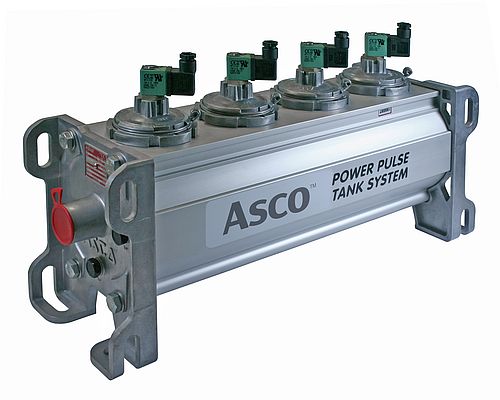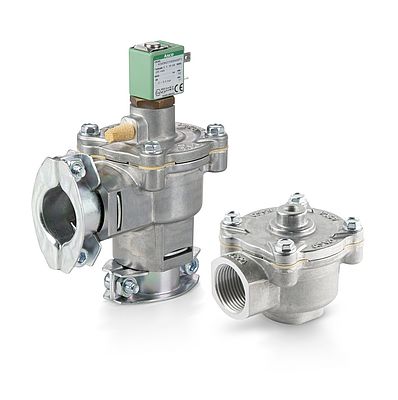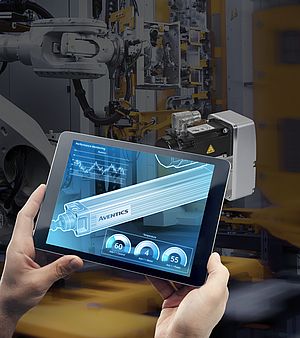IEN Europe: What should a plant operator look for when choosing a dust collecting system?
Samuele Oliva: First of all, high peak pressure. Peak pressure determines the speed and power of the compressed air burst a pulse valve emits when it cleans the filters in a dust collector. Pulse valves that quickly hit high peak pressure increase the efficiency of the dust collector’s overall performance. The ASCO™ Series 355B Power Pulse Tank System offers the highest peak pressure and flow performance on the market.
Secondly, a fast valve response time. Pulse valves that open and close quickly not only improve filter cleaning, but they also use less compressed air.
Last, easy installation and maintenance. Plant operators should consider the investment in installation and labor costs when choosing a dust collector system. The more complex the valves in a dust collector system are, the more time and labor costs they will consume when it comes time to install or to disassemble for annual maintenance. One way to save even more time is through Emerson’s patented Quick Mount Clamp connection, which makes installation and maintenance fast and easy. The Quick Mount Clamp is featured on the ASCO Series 353 Pulse Solenoid Valve.
Valves disassembly and or installation can be time consuming. Can you tell us more about the Quick Mount Clamp feature?
Compared to other connection types, the Quick Mount Clamp reduces installation time by 60%. This is especially significant when you consider that installation takes time for original equipment manufacturers (OEMs) and end users alike. Conventional valves have threaded or dresser fitting connections. Quick-mount clamp connection valves connect to pipework more easily and quickly than threaded and dresser connections and require no special tools or additional sealing.
When specifying pulse valves, it’s important to consider how complex the installation process will be. Do they require special tools? Do they have a lot of parts? The more complex valves are to install, the more time and labor costs they will consume.
What is the role of a pulse valve in a dust collecting system?
When a dust collector is in operation, it draws dusty particles onto its filters. As particles accumulate, they compress into cakes. These cakes can block filters, reducing the dust collector’s efficiency. To remove dust particles from filters, pulse valves periodically blast compressed air, which sends a shockwave through the filters. When the shockwave hits the dusty cakes, they crumble off the filters. As a result, pulse valves are critical to the system. Without them, dust cakes would continue to accumulate and lower the efficiency of the dust collector. One example of these critical valves is the ASCO Series 353 Pulse Solenoid Valve. The product’s high flow rates, higher peak pressure and fast response time deliver optimal filter cleaning performance while using less air.
How do pulse valves improve dust collector performance?
Reliable pulse valves help lower emissions, energy consumption and operating costs. Compressed air can be expensive for processing facilities, and plants with multiple dust collector systems may use a lot of it. The length of time the valve is open determines how much compressed air is used. Choosing a pulse valve with quick response times leads to less compressed air consumption compared to pulse valves with slower response times. The pulse time can be reduced by having a more efficient way to use the air as well. In addition, dust collector systems rely on pulse valves to clear out filters. Without pulse valves, dust would continually clog filters, resulting in downtime and higher operating costs.
What efforts does Emerson support to reduce carbon footprints?
At Emerson, we have a three-part sustainability framework, Greening Of, Greening By and Greening With. It is part of Emerson’s purpose to help support and enable our customers’ decarbonization and environmental sustainability efforts, which we call Greening By. One way that we do this is through energy-efficient solutions, like the Series 355B Power Pulse Tank System and Series 353 Pulse Valves. The high peak pressure and fast valve response time these solutions feature can reduce compressed air consumption. This, in turn, reduces the energy used by the compressor to produce the air and carbon emissions. Compressed air savings can be substantial when multiplied across an entire plant.
In addition to compressed air savings, providing a high-pressure pulsing can reduce the number of pulsations needed to efficiently clean the filters and thus extend filter life, increasing the filtering efficiency and reducing the waste generated by the replacement of the filter themselves. This also reduces maintenance and purchasing costs.
Can you tell us about successful application stories the ASCO Series 353 Pulse Solenoid Valve have been part of?
We have installed the Series 353 pulse valve around the world, and the positive results are extensive. This includes OEMs manufacturing laser cutting and dust collector solutions as well as end users with applications such as carbon black manufacturing and steel mills, especially in the Asia Pacific region. We’ve also had great success with applications in the rubber manufacturing and chemical industries. Our extensive portfolio of dust collector equipment and global footprint allow our customers to supply components from a single supplier, including explosion-proof solenoid valves and pressure vessel. Our products are able to deliver consistent results in standard applications like cement to less common applications like biomass plant cleaning.
Do you foresee any technical developments in the dust filtration systems side? Are the number of applications using them increasing?
Digital transformation is changing every business, including dust collector applications. The increased insights in the technical parameters of dust collector equipment and improved automated controlling will eventually lead to lower emissions, a more efficient plant operation and reduced maintenance.
In response to the trend of reducing complexity in manufacturing and plant operation, influenced by the need for high production levels despite worker shortages, it will be ever more valuable to have simple and complete solutions that reduce working time and complexity.
Visit Emerson at the Powtech Show, Hall 3/Booth 482
Anis Zenadji




















